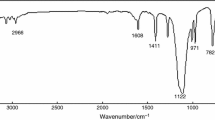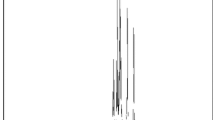Abstract
Hexakis(4-nitrophenoxy) cyclotriphosphazene (HNTP) was synthesized and was added into polycarbonate (PC) functioned as intumescent flame retardant and charring agent. The chemical structure of HNTP was confirmed by hydrogen and phosphorus nuclear magnetic resonance (1H-NMR, 31P-NMR), energy-dispersive spectroscopy and Fourier transform infrared (FTIR). Flame retardancy and charring–forming behaviors of HNTP- and PC-based composites were extensively investigated with the limiting oxygen index, UL-94 vertical burning test, microscale combustion calorimeter (MCC) and thermogravimetric analysis. The water resistance of PC-based composites was studied by stationary water contact angle measurements. Furthermore, TG/FTIR was used to research their gaseous products and their releasing intensity during the decomposition. The morphology and chemical structure of residual char were used to study scanning electron microscopy (SEM) analyses and FTIR spectroscopy. The mechanical properties of samples were compared by tensile and impact tests.
















Similar content being viewed by others
References
Zhang F, Li Q, Liu Y, et al. Improved thermal conductivity of polycarbonate composites filled with hybrid exfoliated graphite/multi-walled carbon nanotube fillers. J Therm Anal Calorim. 2016;123(1):431–7.
Gaur MS, Rathore BS. Structural and thermal properties of swift heavy ion beam irradiated polycarbonate/zinc oxide nanocomposites. J Therm Anal Calorim. 2015;119(2):1105–12.
Yang Y, Liu J, Cai X. Antagonistic flame retardancy between hexakis(4-nitrophenoxy) cyclotriphosphazene and potassium diphenylsulfone sulfonate in the PC system. J Therm Anal Calorim. 2016;126(2):571–83.
Yang Y, Kong W, Wang Y, et al. Synthesis of tris(phenoxy)trifluorocyclotriphosphazenes and study of its effects on the flammable, thermal, optical, and mechanical properties of bisphenol-A polycarbonate. J Therm Anal Calorim. 2015;122(2):805–16.
Zhang W, Li X, Guo X, et al. Mechanical and thermal properties and flame retardancy of phosphorus-containing polyhedral oligomeric silsesquioxane (DOPO-POSS)/polycarbonate composites. Polym Degrad Stab. 2010;95(12):2541–6.
Alongi J, Han Z, Bourbigot S. Intumescence: tradition versus novelty. A comprehensive review[J]. Prog Polym Sci. 2015;51:28–73.
Yang Y, Kong W, Cai X. Two phosphorous-containing flame retardant form a novel intumescent flame-retardant system with polycarbonate. Polym Degrad Stab. 2016;134:136–43.
Zhou L, Zhang G, Li J, et al. Synthesis and characterization of polyphenylaminophosphazene and fluorinated polyarylaminophosphazene. J Appl Polym Sci. 2015;132(37).
Akbaş H, Okumuş A, Karadağ A, et al. Phosphorus–nitrogen compounds. J Therm Anal Calorim. 2016;123(2):1627–41.
Liang W, Zhao B, Zhao P, et al. Bisphenol-S bridged penta(anilino)cyclotriphosphazene and its application in epoxy resins: synthesis, thermal degradation, and flame retardancy. Polym Degrad Stab. 2017;135:140–51.
Zhao B, Liang W, Wang J, et al. Synthesis of a novel bridged-cyclotriphosphazene flame retardant and its application in epoxy resin. Polym Degrad Stab. 2016;133:162–73.
The study of char forming on OPS/PC and DOPO-POSS/PC composites.
Zhang X, Zhang L, Wu Q, et al. The influence of synergistic effects of hexakis(4-nitrophenoxy) cyclotriphosphazene and POE-g-MA on anti-dripping and flame retardancy of PET. J Ind Eng Chem. 2013;19(3):993–9.
Zhang S, Horrocks AR. A review of flame retardant polypropylene fibres. Prog Polym Sci. 2003;28(11):1517–38.
Zhang X, Zhong Y, Mao Z. The flame retardancy and thermal stability properties of poly (ethylene terephthalate)/hexakis(4-nitrophenoxy) cyclotriphosphazene systems. Polym Degrad Stab. 2012;97(8):1504–10.
Liu Y, Huang K, Peng D, et al. Synthesis, characterization and hydrolysis of an aliphatic polycarbonate by terpolymerization of carbon dioxide, propylene oxide and maleic anhydride. Polymer. 2006;47(26):8453–61.
Pawlowski KH, Schartel B, Fichera MA, Jager C. Flame retardancy mechanisms of bisphenol A bis(diphenyl phosphate) in combination with zinc borate in bisphenol A polycarbonate/acrylonitrile–butadiene–styrene blends. Thermochim Acta. 2010;498:92–9.
Lee LH. Mechanisms of thermal degradation of phenolic condensation polymers. I. Studies on the thermal stability of polycarbonate. J Polym Sci Part A Polym Chem. 1964;2(6):2859–73.
Wawrzyn E, Schartel B, Seefeldt H, et al. What reacts with what in bisphenol A polycarbonate/silicon rubber/bisphenol A bis(diphenyl phosphate) during pyrolysis and fire behavior? Ind Eng Chem Res. 2012;51(3):1244–55.
Levchik SV, Camino G, Luda MP, et al. Thermal decomposition of cyclotriphosphazenes. I. Alkyl-aminoaryl ethers. J Appl Polym Sci. 1998;67(3):461–72.
Acknowledgements
We would like to thank the generous supports by the following: the Experiment Center of Polymer Science and Engineering Academy, Sichuan University.
Author information
Authors and Affiliations
Corresponding author
Rights and permissions
About this article
Cite this article
Yang, Y., Luo, H., Cao, X. et al. Preparation and characterization of a water resistance flame retardant and its enhancement on charring–forming for polycarbonate. J Therm Anal Calorim 129, 809–820 (2017). https://doi.org/10.1007/s10973-017-6251-2
Received:
Accepted:
Published:
Issue Date:
DOI: https://doi.org/10.1007/s10973-017-6251-2




